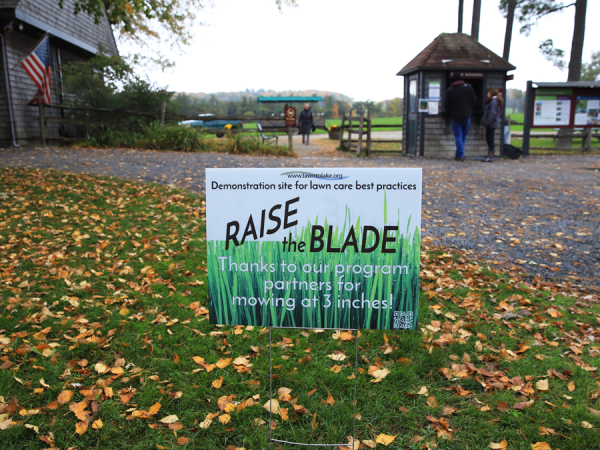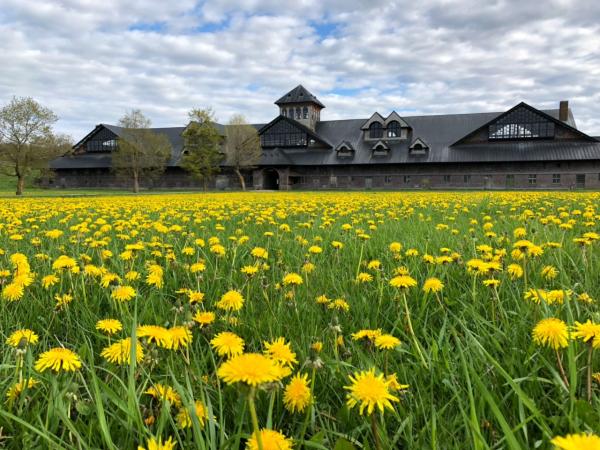Thank you for this article and for the commitment to change your perspective on what a lawn actually means in terms of our collective environment. Letting lawns "go," or, as you are doing, mowing less, will do wonders for the environment as well as for birds, insects, and small mammals. There is no better way to educate than to lead by example!
Farm Lawns, Reimagined
Along with its heavy toll, the COVID-19 pandemic has opened up fresh opportunities to re-envision the future we want. This is happening at scales both grand and humble. One unexpected, and simple opportunity it has given the Farm is the chance to revisit… our lawns.
Finely groomed lawns have been an environmental flashpoint for decades. At more than 40 million acres, America’s lawns are the nation’s largest irrigated crop. Mowers consume 1.2 billion gallons of gasoline a year (about 1% of the total), emit particulate pollutants into the air, and discharge fertilizer into our waters. Collectively, that all has a climate impact. Lawns sequester carbon, too, although the carbon credit shrinks when you factor in all the other maintenance inputs required (think lush green lawns in Arizona, for example).
Over the past few years, the Farm has joined forces with two initiatives educating the community about lawns. In partnership with Burlington City Arts, and as an exhibit in connection with 2018 art show at the Coach Barn, artist Brian Collier marked small sections of roadside lawn that were left to grow tall and shaggy, as part of his Unlawning America project. The project explores the environmental value of doing exactly nothing with your lawn.
The Farm has also adopted and advocated for “Raise the Blade” -- an environmental campaign encouraging homeowners to maintain slightly taller lawn grass by raising their lawnmower blades to at least 3 inches. (We actually raised ours higher -- mostly to 4 and 5 inches.) This ongoing campaign of the Lake Champlain Basin Program is an effort to improve the health of our soils and waterways, like Lake Champlain.
This year, the Farm’s environmental commitment, coupled with limited hiring of seasonal staff due to COVID-19, has pushed us to take "Unlawning" and “Raise the Blade” a step (and a few inches) further. Our plan for the summer includes mowing less often, on fewer acres, and with a raised blade.
We started by asking what areas were considered important to keep mowing, then worked backwards. These areas include lawns around residences, five-foot-wide ribbons along roadsides and walking trails, the inn’s back lawn and gardens, Farm Barn courtyard, Sheep’s Knoll, and the elm tree allee along the main drive.
We’ll shrink the footprint of our maintained lawns then keep them at 4” or 5”. That means that we won’t cut the grass until it reaches 8.5” in height, which is good environmentally. Grass that’s cut when it’s taller grows back more slowly -- requiring less frequent mowing throughout the season.
In other areas, including many larger swaths like the north lawn of the Farm Barn or the Breeding Barn lawn, we will only mow 3-4 times this season. (We may possibly graze sheep on them, too.) All lawns beyond the road- and trail-side mowed ribbons will also only be cut 3-4 times a year.
With this mowing schedule, you might see grasses upwards of 12-18” tall. But the spaces are scattered and generally too small for haying equipment, so we’ll cut the grass with a mulching mower (a flail mower, to be exact), which can manage the tall grass better and won’t leave behind matted cuttings to suffocate new growth.
Last year, we mowed 62 acres of lawn (distinct from cutting fields for hay). This year, we'll half that at least. And what used to take four staff four days to mow, will now take two staff 2 or 3 days. We’re excited about the opportunity to reduce our carbon footprint and see how the effects shift the aesthetic of the Farm.
If you stop by this season, think of the Farm as that friend you’ve grown accustomed to seeing with untrimmed hair or graying roots. We hope you’ll appreciate the thoughtful planning behind the more natural pastoral look as well as its environmental benefits. We also hope you’ll consider “raising the blade” on your own lawns.
Comments
What about planting a low-growing ground cover (like creeping thyme) in place of grass? Then you would not need to mow those areas at all! I know a church that did that on their postage stamp size city lot; it was a huge success!
I live in an HOA, but am going to stop my lawn service soon and will be interested in how or what you are doing to your grasses.



